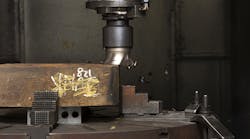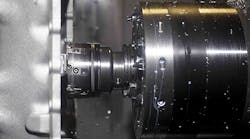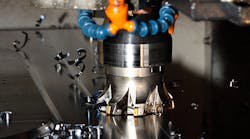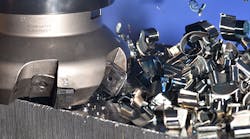Certainly, moving a punishing mainstay job to an older, looser machine can be risky. But, with proper tooling, it can also raise opportunities to improve efficiency and profitability.
Just ask Peter Dinh, president of Cyber Manufacturing LLC, a busy 60-man job shop in Houston that caters to oil-and-gas industry customers. Cyber Manufacturing moved a very challenging, roughing job from a tight new Mazak to a very loose Kingsbury milling machine dating to 1980, and fiddled with the tooling. Results: a five-to-one saving in machining time, and a six-fold improvement in edge life, leading to a $100,000 yearly savings in machine time and MRO costs.
The tooling switch was from an Ingersoll IS0-Plus face mill to the same company’s Hi-QuadXXX™ indexable mill, an unlikely choice because it is nominally a high-feed mill known for fast feeds and shallow passes. But, here it handles depths of cut in the 0.300-in. range. “Our 24/6 operating schedule doesn’t leave much time for error -- or experimentation either,” said Dinh, “so we rely on Ingersoll for quick, practical solutions.”
Quick? For Cyber Manufacturing, the solution was put in place literally overnight.
The job in question involves rough-milling large process valve gates out of 4140 steel
forgings with heavy oxide crusts. It runs continuously at a yearly volume of 500-750 pieces. The roughly rectangular parts measure 29x14x14 in. and need about three-quarters of an inch removed per side, or about 609 cubic inches. The finished parts become very precise sliding gates for big valves used in petroleum distribution systems. Still, the incoming forgings typically have a 0.125-0.175 inch abrasive oxide crust. Coatings on some of them measure more than 0.250 in.
In mid-2014, to free its new 50-HP Mazak for more high-precision work, Cyber bought a 30- year-old Kingsbury with a 25HP, specifically to continue the valve gate job, and tooled it with the same ISO-Plus used on the Mazak. The job ran well enough on the Mazak despite the cutter’s 0.040-in. depth limitation, which required multiple passes even to get through the oxide crust down to bare metal. But, on the looser Kingsbury, cutting edges didn’t last a single pass.
New facemill for vintage machine — Ingersoll field rep Mike Salewsky sized up the problem right away. “Those oxides eat carbide cutting edges for lunch. We have to get through the oxide with the initial pass, regardless of its depth, without overloading the spindle.”
Accordingly he recommended a 3-inch Hi-QuadXXX mill, a high-feed mill with 13-mm inserts able to take off up to 0.250 in. per pass. “The part geometry called for a larger cutter able to go deeper, but the old Kingsbury’s weary bones and horsepower limitation suggested starting small,” said Salewsky.
Assisted by Tam Nyghen of local distributor United Tool and Supply, Mike got the tool to Cyber overnight and came in the next day to set it up and go operational. After a couple of trial passes on the actual part, they arrived at 756 rpm, 75 IPM, 0.200-in. DOC as the optimal parameters. At those settings, the removal rate more than doubled, versus the earlier ISO-Plus. Cutting edges lasted through an entire part, including both sides and 4-6 complete passes.
Even at these settings, the 25 HP spindle showed no signs of overload. Spindle loads stayed well under 60%. And, despite the machine’s loose frame, the operation ran very quietly with no hint of hammering or chatter. “The process was stable, so it seemed worthwhile to go with a larger cutter able to cut even deeper and complete the part faster,” said Salewsky. “Moreover, the oxide skins on some of the forgings run 0.300 in. or more.”
More Cutting Depth... No Edge Loss
So, Mike brought in a 4-in. Hi-QuadXXX with 19-mm inserts capable of 0.300-0.500 depth of cut. Working with programmer Ken Dinh, he fine-tuned the parameters to 477 rpm, 50 IPM, and 0.300-0.500-in. DOC, depending on the oxide thickness of the piece to be machined. At these settings, the removal rate doubled again, with no loss of edge life. Some edges lasted through more than one part, or 6-10 passes. “At these settings, particularly the depth of cut, the cutting edges encountered metal only and no oxide,” Salewsky reported.
The Ingersoll Hi-QuadXXX face mill may have seemed an odd choice for this deep-cut application, since it is known better for quick, shallow cuts. “Here each pass removes more than 200 mils, definitely beyond the ‘comfort zone’ for a typical high-feed tool,” Salewsky explained. “This one is really an all-purpose tool.”
The cutter uses an extra thick insert and extremely rigid seating for durability and process security. Positive rake geometry and 30-degree bevel angle combine to reduce lateral cutting forces and enhance stability all the way from entry through exit.
“It’s the free cutting geometry that enables such deep cuts without stalling or overloading the 25HP machine,” said Salwesky. Pro forma calculations confirm that with conventional tooling, the removal rates achieved here would require a 70-HP machine.
Coating treatment makes 35% difference — The tougher insert, Ingersoll grade IN4005, contributed significantly to the improved edge life. It features an advanced post-coating technology that reduces microcracks and leaves a smoother, slipperier cutting edge.
“The 4000 series inserts cost 7% more but typically deliver 35% more efficient metal removal and triple the edge life,” said Salewsky. This improvement stems from the way the aluminum-oxide coating is deposited. The process is pressure vapor deposition (PVD), which operates at lower temperature than chemical vapor deposition (CVD), and thus creates a more lubricious surface and more durable bond between coating and substrate. The insert also is etched more deeply to enlarge the gripping area.
As a result of this success, Cyber plans to use the Ingersoll Hi-QuadXXX for most rough milling, especially the crusty jobs. “I was certainly pleased with the improvement but not really surprised,” said Cyber Manufacturing president Peter Dinh. “Mike’s solutions usually improve things right away, without a lot of guesswork. He’s like a company tool engineer without the payroll costs. Besides, Ingersoll didn’t charge anything for the advice, trial tools, demos and setup assistance.”














